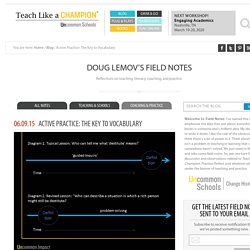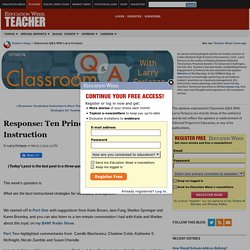

Checking Understanding. Analysis of the language consists of two sub-stages, often known as highlighting and concept checking.

Highlighting is taking the model sentence and showing, telling or eliciting what the problems are in terms of form, function, and phonology. Concept checking is checking the understanding of difficult aspects of the target structure in terms of function and meaning. Concept checking is vital, since learners must fully understand the structure before any intensive practice of form and phonology is carried out. Ways of checking understandingConcept questionsSome examplesLearning to construct concept questionsConclusion Ways of checking understanding Concept checking is normally achieved by the use of a set of questions designed to ensure comprehension of the target language, raise awareness of its problems, and to indicate to the teacher that the learners have fully understood. The question 'Do you understand? ' Time lines to establish tenses. Target sentence: Look! Yes/no questions. GOOD (adjective) definition and synonyms.
100 IELTS Essay Questions. Reading Teachers: teachers who read and readers who teach. More research details Whilst all the Teachers as Readers (TaRs) project teachers widened their reading repertoires, documented their reading practices and developed their own pleasure and understanding about the process of reading, from the outset many expressed reservations about developing as Reading Teachers.

They were unsure of the value of opening up themselves as readers in class and taking the time to share with the children something of their personal engagement as readers and their reading lives and practices. Many found the innovative nature of a Reading Teacher stance created uncertainty. They felt they needed to foreground the prescribed reading objectives from the curriculum and, whilst other changes to their pedagogic practice were made, some were reticent to risk introducing this personal dimension.
Over the project year, a continuum of practice developed. To read more about this focus see the Executive Summaries, and related chapters/papers on For example: 1. 2. 3. 4. 5. Active Practice: The Key to Vocabulary - Teach Like a Champion. We’ve just finished our chapter on vocabulary in Reading Reconsidered.

In it, we describe ways to teach new words directly (Explicit Vocabulary Instruction) and ways to increase how much word knowledge students absorb from reading words in texts (Implicit Vocabulary Instruction). The following is from our discussion of Explicit Vocabulary Instruction and talks about the key role of Active Practice—causing students to practice applying and using a word.
We think it’s the key to improving vocabulary instruction. We should note that much of what we write here represents adaptations of the ideas Beck, McKeown and Kucan discuss in their book Bringing Words to Life. Explicit Vocabulary instruction includes five steps: Of these, we believe the fourth step, active practice, is the most important. This would mean replacing something like, “Who can tell us what ‘destitute’ means?” Animalium. Four Practical Principles for Enhancing Vocabulary Instruction. Literacy researchers and teachers have shown an increased interest in vocabulary instruction over the past decade.

In 2000, the National Reading Panel identified vocabulary instruction as one of the five essential components of reading instruction, and a large body of research indicates the critical role vocabulary knowledge plays in reading comprehension (August, Carlo, Dressler & Snow, 2005; Baumann, 2009; Chall, Jacobs, & Baldwin, 1990; Cunningham & Stanovich, 1997, Mancilla-Martinez & Lesaux, 2010). Education Week. (Today's post is the last post in a three-part series.

You can see Part One here and Part Two here) This week's question is: What are the best instructional strategies for vocabulary development? We started-off in Part One with suggestions from Katie Brown, Jane Fung, Marilee Sprenger and Karen Bromley, and you can also listen to a ten-minute conversation I had with Katie and Marilee about this topic on my BAM! Radio Show. Part Two highlighted commentaries from Camille Blachowicz, Charlene Cobb, Katherine S. In today's third, and final, segment, Laura Robb and Amy Benjamin share their thoughts, and I also include readers' comments. Response From Laura Robb Laura Robb, teacher and coach, has written more than 20 books on literacy. A recent NAEP study demonstrates that one of the main reasons students read below grade level is due to vocabulary deficits.
The Big Ten Approach. Babcock LDP - Primary and Secondary English Reading. This resource is a collection of reading plans based on high quality texts for teaching reading from Y1 to Y6.

Although the texts are not included, many are well-known books that will be in school libraries and some are freely available online. Re-think Reading! Is organised in phases of Y1, Y2, Y3/4 and Y5/6 with at least 12 sets of plans per phase. Re-think Reading! Covers many aspects of the National Curriculum for reading but is not totally comprehensive. National Curriculum Objectives Each set of session plans focuses on objectives from the National Curriculum for reading for the relevant year group or phase. Oxford University Press - Word Gap - Oxford Language Report.
The Oxford Language Report has found evidence of a significant word gap in UK schools which is holding back children's learning.

Find out how you can help. To better understand the word gap, we've carried out market research with more than 1,300 teachers in the UK. Over half of those surveyed reported that at least 40% of their pupils lacked the vocabulary needed to access their learning. See below our wealth of resources to support you in closing the word gap in your school.
You can help to close the word gap by becoming a Word Gap Partner School. Benefits of becoming a Word Gap Partner School: Demonstrate your commitment to closing the word gapReceive free resources to use in your classroomGet the chance to test-drive new initiatives and inform researchReceive exclusive invitations to closing the word gap events.